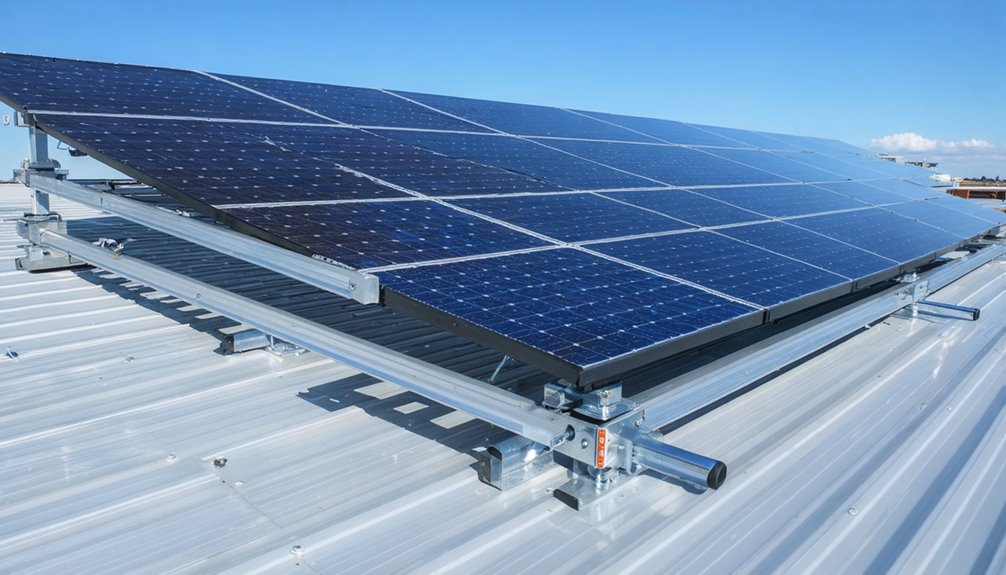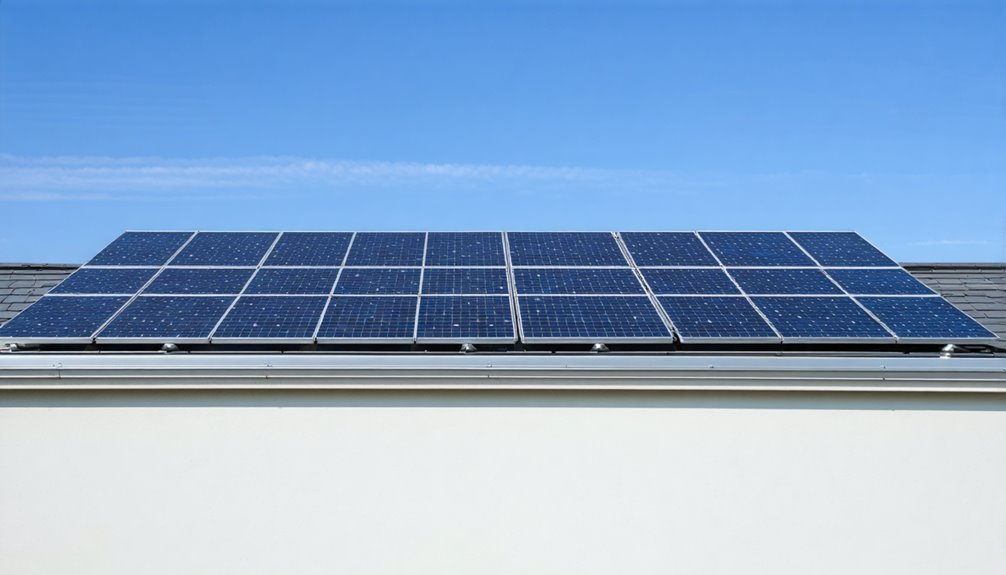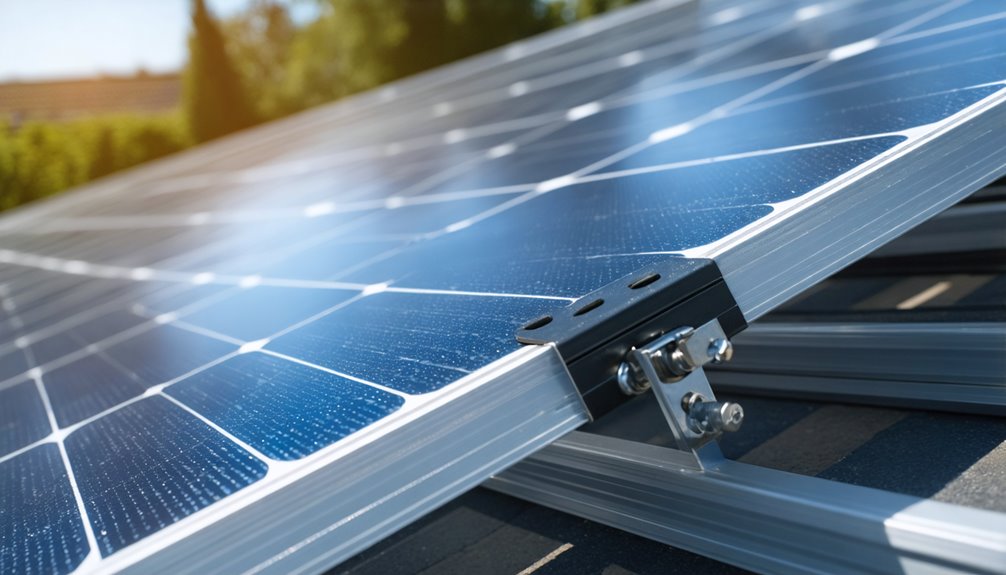Traditional solar panels don’t typically have mounting holes on their back; instead, they feature pre-drilled holes along the aluminum frame. This design guarantees secure, efficient attachment to various racking systems without compromising structural integrity. Aluminum frames with pre-drilled holes simplify the mounting process, preventing the need for direct roof penetration while enhancing installation reliability and efficiency. Understanding the function and positioning of these mounting holes can help you optimize your solar panel setup for maximum performance.
Key Features of Solar Panel Design
Solar panel design incorporates several key features that guarantee both efficient energy production and robust structural integrity. You’ll find that solar panels have mounting configurations designed for stability and durability through pre-drilled aluminum frames. These frames support mounting systems, although they don’t possess back mounting holes, thereby elevating installation reliability and efficiency. The panel’s glass cover maximally protects photovoltaic cells from environmental hazards while maximizing light absorption to aid energy conversion. Underneath, a sealed backsheet prevents moisture intrusion and shields against UV exposure, further safeguarding critical internal components. These features illustrate the careful engineering aimed at ensuring the longevity and performance of solar panels, balancing protection with high-efficiency design. Consequently, the integration of these components aligns perfectly with modern energy needs. Pre-drilled aluminum frames support mounting systems and improve installation reliability pre-drilled frames.
Role of Aluminum Frames in Mounting
Structural integrity and efficiency in solar panel design hinge on meticulous engineering, with aluminum frames playing a significant role in mounting. These frames serve as the backbone of your solar panels, securely interfacing with mounting systems through pre-drilled holes, effectively eliminating the need for holes in the back. Their lightweight nature doesn’t compromise strength, ensuring easy handling during the installation process whether on rooftops or ground mounts. Aluminum frames enhance durability by providing robust protection against environmental stressors, maintaining ideal panel alignment throughout solar panel installation. They also streamline installations; clamps grip frame sides, simplifying setup. Additionally, aluminum’s heat dissipation properties bolster panel efficiency and lifespan. Consequently, aluminum frames are essential, ensuring a seamless installation and lasting solar energy harnessing. Additionally, the aluminum frames offer heat dissipation benefits that help maintain panel efficiency and lifespan.
Importance of a Sealed Backsheet
While the sealed backsheet of a solar panel might seem like a simple component, it plays an essential role in protecting the photovoltaic cells from environmental threats, ultimately enhancing the panel’s longevity. Moreover, choosing compatible mounting systems that meet wind and structural certifications can support the backsheet’s protections and influence warranty coverage. It forms a key barrier against moisture infiltration, which can greatly damage photovoltaic cells, leading to decreased efficiency over time. Additionally, this backsheet protects against ultraviolet rays, reducing deterioration risks and guaranteeing the solar panel remains durable. Its design facilitates effective heat dissipation, critical for maintaining maximum efficiency during temperature variations. Remarkably, a sealed backsheet with no mounting holes contributes to the panel’s structural integrity by offering a sleek and clean design that minimizes potential failure points. This robust construction guarantees ideal conditions for energy capture, thereby maximizing photovoltaic cell output.
Understanding Racking Systems

As the importance of a sealed backsheet underscores the need for protection and efficiency within solar panels, understanding the function and design of racking systems becomes essential for their effective deployment. Racking systems are critical for securely attaching solar panels to surfaces, using panel mounting systems that replace the need for back mounting holes with pre-drilled frames. Various installation methods, like rail-based or ballasted mounts, enhance stability, allowing for optimized angle adjustments under diverse environmental conditions.
| Key Feature | Description |
|---|---|
| Mounting Options | Include roof, ground, and pole options for adaptable setups. |
| Panel Mounting Systems | Utilize pre-drilled frames for secure attachment via clamps or rails. |
| Installation Methods | Rely on rail-based, ballasted systems, adjusting to environmental demands. |
Roof-mounted racking systems align with structural elements, while ground mounts elevate panels, maximizing energy production. Selecting the right mounting approach also involves choosing between roof, ground, and pole options to fit your environment, while pre-drilled frames enable quick, secure integration.
Differences Between Roof, Ground, and Pole Mounts
Solar panel installation can employ various mounting techniques, each tailored to specific site requirements and environmental conditions. A thorough design should consider site topology and load requirements to optimize performance and safety, including structural support. Roof mounting leverages the existing structure, integrating with rails and clamps to secure solar panels without needing back mounting holes, ensuring minimal disruption to the roof’s integrity. Ground mounts offer flexibility in positioning and angle adjustments, ideal for properties with ample land, allowing for ideal solar exposure while maintaining the panel’s structural integrity. Pole mounts elevate panels above ground level, maximizing sun exposure and reducing shading from nearby objects, supported by anchoring mechanisms for stability. All mounting systems utilize specialized racking frameworks that provide essential structural support and stability against environmental challenges like wind and weather, vital for long-term operational efficiency.
Advantages and Disadvantages of Back Mounting Holes
The absence of back mounting holes in most solar panels offers both distinct advantages and some limitations in installation processes. By not having back mounting holes, you maintain the structural integrity of solar panels, which helps in reducing the risk of leaks and moisture infiltration during rooftop installations. This approach simplifies the manufacturing process, allowing you to mount solar panels with a standardized creation that enhances efficiency and reduces costs. Instead of relying on holes to keep panels in place, specialized mounting systems use adaptable strategies, improving flexibility across different environments. However, this design choice may limit certain installation methods, as not having back mounting holes complicates installations requiring direct attachment to the panel body, often necessitating alternative mounting solutions.
Innovative Mounting Solutions

How do innovative mounting solutions accommodate the absence of traditional back mounting holes in solar panels? Rail-based systems, where solar panels are designed to secure and align easily, eliminate the need for these holes, streamlining the installation process. Adjustable mounting brackets add versatility, allowing panels to be seasonally tilted for maximum sunlight absorption. Ballasted mounting systems utilize heavy weights to hold panels on flat roofs, preventing roof penetration and reducing leak risks. Direct-to-roof mounting options employ specialized field-mounted adapters, adhering to roofs and enhancing installation efficiency without drilling holes. Additionally, snap-in mounting solutions are gaining traction, simplifying installation with quick, reliable attachment methods while maintaining the structural integrity of solar panels, thereby ensuring durability and ease of use.
Best Practices for Panel Installation
When selecting mounting systems for solar panels, you should prioritize options that complement the pre-drilled holes in the aluminum frames, working in conjunction with specialized racking systems to guarantee structural stability and maximize energy capture. Proper alignment with rail-based or ground-mounted setups is vital for optimizing sunlight exposure and overall energy efficiency, helping to maintain the panels’ performance over time. Following the manufacturers’ guidelines during installation and conducting regular maintenance checks will secure the system’s efficiency and longevity while reducing risks associated with environmental factors and roof integrity issues.
Selecting Mounting Systems
Solar panel installation begins with the indispensable step of selecting an appropriate mounting system, guaranteeing both compatibility with your roofing type and the specific model of solar panels you plan to use. When you select the right mounting system, you’re prioritizing both secure attachment and peak performance. Most solar panels don’t have mounting holes on the back, so they rely on pre-drilled holes in their aluminum frames, making it essential to match these with your chosen system. Rail-based mounting systems provide stability, allow for adjustments, and guarantee proper panel alignment. Alternatively, direct-to-roof mounts simplify installation without compromising security. Remember, evaluating roof integrity and adhering to local building codes are fundamental to prevent structural issues, guaranteeing your system’s longevity and efficiency.
Energy Capture Optimization
Proper energy capture optimization is crucial for achieving maximum solar panel efficiency, requiring careful consideration of several key installation practices. When installing solar panels, verify they’re tilted at a favorable angle corresponding to your geographic location, generally between 30 to 40 degrees, to maximize exposure to sunlight. The panels should face true south in the Northern Hemisphere and true north in the Southern Hemisphere for the best energy harvest. Panels have mounting holes to accommodate the right mounting system, which should follow manufacturer guidelines concerning spacing and installation to prevent overheating. Beyond installation, regularly cleaning your panels to remove dirt and debris can enhance energy output appreciably, sometimes by up to 25%. Regular maintenance checks of the mounting systems prevent corrosion, guaranteeing sustained energy benefits of solar.
Benefits of Alternative Mounting Techniques
While traditional methods of mounting solar panels have dominated the market for years, alternative mounting techniques offer distinct advantages in maintaining and enhancing solar installations. Rail-based systems, often integrated into a mounting system, improve panel stability and allow for adjustments without back drilling, thereby preserving panel integrity. Ballasted mounting systems employ heavy concrete blocks, reducing water leak risks by avoiding roof penetration. Snap-in solutions contribute to quicker, more cost-effective solar energy installations. Adjustable brackets guarantee ideal panel angles, adapting to seasonal solar exposure for improved energy capture. In addition, direct-to-roof mounts use industrial adhesives, eliminating drilling and maintaining aesthetic appeal while minimizing failure points.
| Technique | Benefits | Features |
|---|---|---|
| Rail-based | Easy adjustments | No back drilling |
| Ballasted | Reduced leak risk | Uses concrete blocks |
| Snap-in | Quick installation | Cost-effective |
| Direct-to-roof | Clean aesthetics | Uses adhesives |
Ensuring Structural Integrity and Performance
Alternative mounting techniques enhance solar panel installations, yet the focus ultimately centers on guaranteeing structural integrity and peak performance. Most solar panels lack mounting holes on the back, instead utilizing mounting frames secured by clamps on their aluminum edges. This approach minimizes risks like moisture infiltration, preserving the panel’s long-term performance. The absence of back mounting holes provides flexibility for various mounting systems, such as adjustable racks and ballasted solutions, catering to diverse environments. Innovative mounting techniques guarantee a secure attachment while allowing precise alignment for maximum sun exposure, essential for maximizing energy output. Guaranteeing proper installation with suitable mounting systems is imperative in maintaining solar panels’ efficiency and longevity, even under varying weather conditions, thereby safeguarding structural integrity and reliable performance over time.
Conclusion
Solar panel mounting requires careful consideration of multiple design elements, including aluminum frames and sealed backsheets that ensure long-term durability and optimal performance. The selection of appropriate mounting systems—whether for roof, ground, or pole installations—depends on specific site conditions and structural requirements. Advanced mounting solutions, including adjustable and integrated systems, can significantly improve panel efficiency and extend system lifespan when properly implemented.
Successful solar installations depend on following established best practices and maintaining structural integrity throughout the mounting process to maximize energy capture and ensure reliable long-term operation. Solocity Global serves as a trusted exporter of solar panel mounting systems, providing comprehensive solutions that meet international quality standards. The company supplies high-quality mounting hardware and components to clients worldwide, supporting diverse installation requirements across various market segments.


